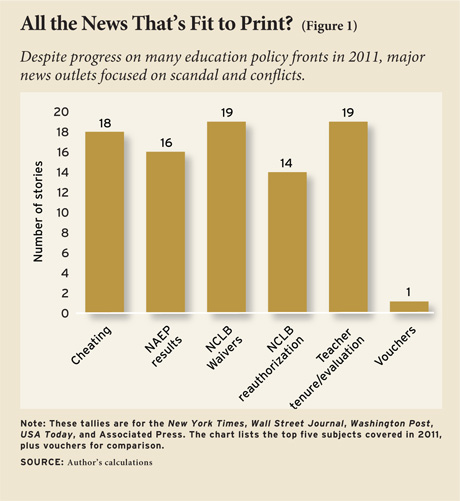Imagine that you’re a casual follower of the education policy debate. You read the major national outlets—the New York Times, Wall Street Journal, Washington Post, and USA Today—and you might come across national Associated Press (AP) stories in your local paper or online news aggregator, too. What would be your view of American education, circa 2011?
In a nutshell: cheating is rampant, national test scores are abysmal, school policy is set in Washington, and teacher tenure is on its last legs. That’s the image implied by the 250-odd education stories published by leading news organizations last year, according to an analysis my team and I did for Education Next. Let us take a closer look.
 As declared by the press, 2011 was “the year of the cheating scandal.” (See Greg Toppo’s year-end story in USA Today, “Schools flunked inquiries into suspicious scores in 2011,” or Dorie Turner’s AP roundup, “2011 marred by test cheating scandals across U.S.”) And sure enough, the media covered the story extensively, with 18 articles published by the national outlets (see Figure 1).
As declared by the press, 2011 was “the year of the cheating scandal.” (See Greg Toppo’s year-end story in USA Today, “Schools flunked inquiries into suspicious scores in 2011,” or Dorie Turner’s AP roundup, “2011 marred by test cheating scandals across U.S.”) And sure enough, the media covered the story extensively, with 18 articles published by the national outlets (see Figure 1).
And how could they resist? Cheating on standardized tests is one of those perfect issues for the press. Not only does it involve immoral behavior and attempted cover-ups on behalf of the perpetrators, it also raises questions about public policies supported by the high and mighty—test-based accountability and teacher evaluation systems in particular. Are the cheating teachers the villains, or the victims? What a great meme!
What’s not clear, however, is whether cheating on standardized tests increased this year, or was it simply discovered by a few enterprising reporters? (Toppo and his colleagues were the first on the case, with a long article about testing irregularities in Ohio and elsewhere in March. Reporters nationwide soon followed suit.) Did the press break the story, or create the story?
If cheating represented fresh meat for the press in 2011, lousy NAEP (National Assessment of Educational Progress) scores played the role of “oldie but goodie.” The major papers published 16 stories on NAEP exams last year, covering subjects that included reading, math, science, history, and geography, plus special results for two dozen urban districts.
And the headlines were almost uniformly negative. “National science test scores disappoint.” “Students stumble again on the basics of history.” “Geography report card finds students lagging.” Only deep in the stories would readers learn that the country has made a great deal of progress in several of these subjects, at least for some students and in some grades. (For instance, in 2010, African American 4th graders scored two grade levels better in U.S. history than they did in 1994.)
Another proclivity of the national press is to obsess about federal policy. Once could argue that, thanks to George W. Bush’s No Child Left Behind Act and Barack Obama’s Race to the Top, Uncle Sam is driving education reform; the media are simply following along for the ride. Still, education remains a state responsibility and a local activity, but you wouldn’t know that from following the major outlets, perhaps because they are located in Washington and New York City. Consider the treatment of the Obama administration’s plan to waive portions of the Elementary and Secondary Education Act (ESEA, aka NCLB). The administration got three bites at the media apple, with widespread coverage in June (when Secretary Arne Duncan first floated the idea), August (when more details came out), and September (when the president made the formal announcement). The national reporters turned in 19 waiver stories altogether.
The press also covered every twist and turn of the (stalled) reauthorization of ESEA. This is reasonable enough; following deliberations on Capitol Hill is a core component of the job of national reporters. But the 14 stories on the topic created the false impression that Washington is the center of legislative activity on education.
When the national press corps did turn its attention to state-level policy, it was mostly around teacher issues. The clashes in Madison, Wisconsin, and Columbus, Ohio, between Republican governors and teachers unions received a good deal of coverage, as did the broader issues of collective bargaining and tenure reform (for 19 articles in all). As former secretary of education Rod Paige once explained to me, the news media are in the “conflict business.” And there was conflict aplenty on the teacher-effectiveness front.
But what about another highly contentious subject: school vouchers? The Wall Street Journal editorial page decreed 2011 “the year of school choice” (sorry “cheating” fans), yet the issue remained almost invisible in the national press (including on the news side of the Journal itself). The only account we could spot was an August AP story, “School voucher bills flood GOP-led statehouses.” These developments weren’t worth noting in the Times or the Washington Post?
The press has long been accused of traveling in a pack. Maybe this year the hordes will discover private-school choice.
This article appeared in the Summer 2012 issue of Education Next. Suggested citation format:
Petrilli, M.J. (2012). The Newsroom’s View of Education Reform: Surprise! The press paints a distorted picture. Education Next, 12(3), 77-78,


